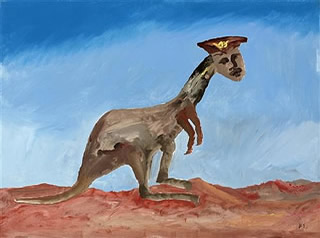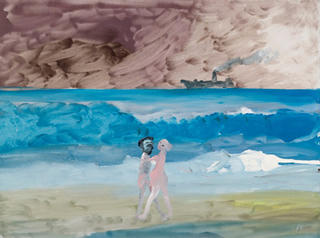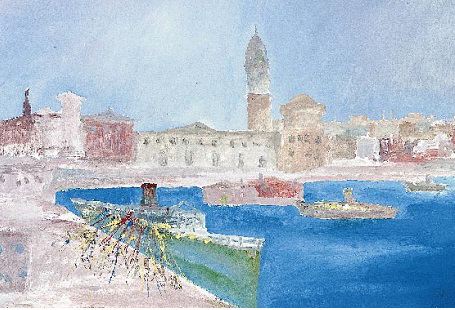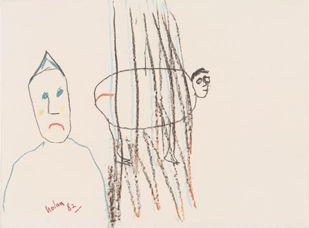D.H . Lawrence's 99 Days in Australia
ART, MUSIC & FILM
|
|||||||||||
"Lawrence & Australian Art" from previous page
He didn't blame Nolan for Cynthia's suicide. It was the re-marriage that appalled him. "What I cannot forgive is his flinging himself on another woman's breast when the ashes were scarcely cold," he wrote. "If it had not been for Cynthia I doubt Nolan would have reached the heights he did in his best period," White wrote. "He would have drowned much sooner in the sea of flattery which sucks so many artists of importance under." Nolan felt bewildered and betrayed by White's turning against him, and was hurt by the virulence of the attack, particularly coming from such an unexpected quarter. He had had no inkling that there was anything amiss with their hitherto close friendship. For the moment Nolan said nothing about White's attack on him. However, at the time Nolan read Flaws in the Glass in 1982, he was in the throes of painting a new series of canvasses based on Lawrence's Kangaroo. (For some time, Nolan had been "illustrating" themes derived from Australian culture and history, searching for iconic figures, such as Ned Kelly, to represent or symbolise Australian themes.) Having read Kangaroo, he chose various scenes from the novel to represent – to borrow Lawrence's famous phrase – Australia's "spirit of place" The first six of the eight pictures are lyrical, almost-pastoral images. In one, "Rainbow", Somers and Harriett are seen walking along the beach at Thirroul. In "Picnic Falls" the couple are dwarfed by the bush landscape around them. "Moon" shows a bright yellow disc suspended over Perth. "Heaven" shows the couple among the wattle blossoms in the bush. "Streamers" depicts the Lawrences' boat leaving the wharf in Sydney, streamers still attached to it side. "Chic" (see above) depicts the couple about to make love after Lawrence went for a swim below Wyewurk. It now seems likely that these six works were painted before Nolan read Flaws in the Glass – or at least before it had time to sink into his consciousness.
The final two works, however, display a sharp change of mood (perhaps |
analogous to the "sudden turning" of Lawrence's "silvery freedom" in Kangaroo). The cruellest was the diptych, which Nolan called "Nightmare". He had been deeply moved by "The Nightmare" chapter in Kangaroo (where the Somers/Lawrence character is called up for army service and humiliated by intrusive physical examinations). However, the diptych which emerged from Nolan's pen and brush in October 1982 went far beyond anything which Lawrence's chapter could have evoked. The preliminary sketch for the diptych is possibly even more explicit than the diptych itself. It depicts a figure with White's features, wearing what looks like an RAF forage cap. Beside this figure is a large flea-like creature with a slash of crimson on its rear, mirroring the dash of crimson of White's mouth, and with a face unmistakably resembling Manoly Lascaris, White's lover. The Manoly figure,which is scored through angrily, appears to be a reference to Hieronymus Bosch's painting, "The Garden of Earthly Delights". The resulting diptych (painted a day after the sketch, on October 27, 1982) shows on one panel a figure once more resembling White, but this time wearing, not just the RAF forage cap, but a full RAF officer's uniform – the uniform White, who had been in RAF intelligence, might have been wearing at the end of the War when he first met Manoly in Alexandria. The features are wizened, the eyes stare madly, and the mouth is twisted in a paroxysm of repulsiveness. The other half of the diptych again depicts the flea-like creature, once more with Manoly's features, but this time in full colour, with a background that resembles excrement. Again, the crimson on the flea's rear is matched to that of White's mouth. So that there could be no doubt whom it was intended to represent, on the side of the flea's body Nolan painted a Greek crucifix. Nancy Underhill comments: "The timing of Sidney Nolan doing his Kangaroo series and finding out about Flaws in the Glass is a coincidence, but one Sid would seize upon. So The ‘Nightmare' is a combined reference to Nolan's state of shock, Patrick's and Manoly's sex-life, and how Nolan paid people back." It is not known whether White ever saw the diptych, but he and Nolan never corresponded, spoke or saw each other again. The final work in Nolan's "Kangaroo series" – the eighth – was painted the day after the "Nightmare" diptych. Earlier, Nolan had also become interested in Eric Campbell's 1930-32 New Guard – another "Australian icon" – and had already created several works depicting the Sydney Harbour Bridge opening ceremony, where the New Guard's Captain de Groot prematurely cut the ribbon "in the name of the decent and respectable people of New South Wales". In the final picture of the series, Nolan introduced the image of a kangaroo, presumably to represent the main character in the novel, Benjamin Cooley, the "Kangaroo" of the title. But Nolan's kangaroo was no ordinary Australian marsupial. He was no "Skippy" Nolan portrayed this kangaroo in a slightly reptilian aspect – a sort of small dinosaur, with "paws" caked up to its armpits in what appears to be dried blood. This reptilian creature is wearing what looks like an Air Force officer's hat, its human shield-like face twisted unnaturally towards the viewer. Given the circumstances of the composition of this final "Kangaroo series" painting, it is difficult to avoid its identification with Patrick White, who has now become, in Nolan's eyes, the fascist leader from Lawrence's Australian novel. |
||||||||||
Next Page: Art Page 3



